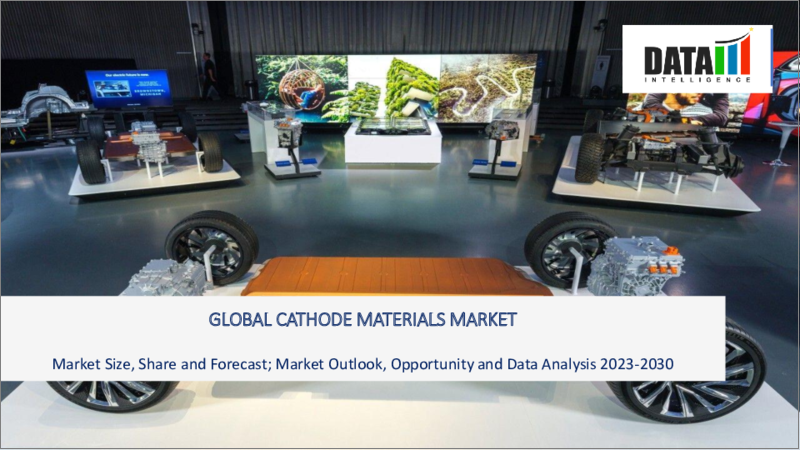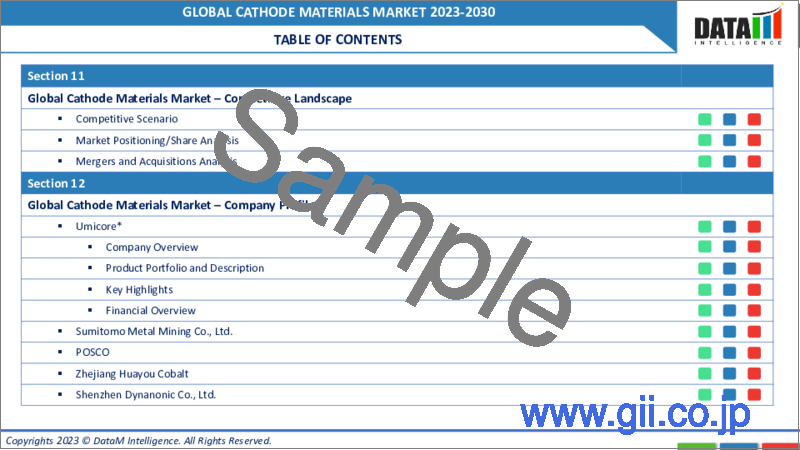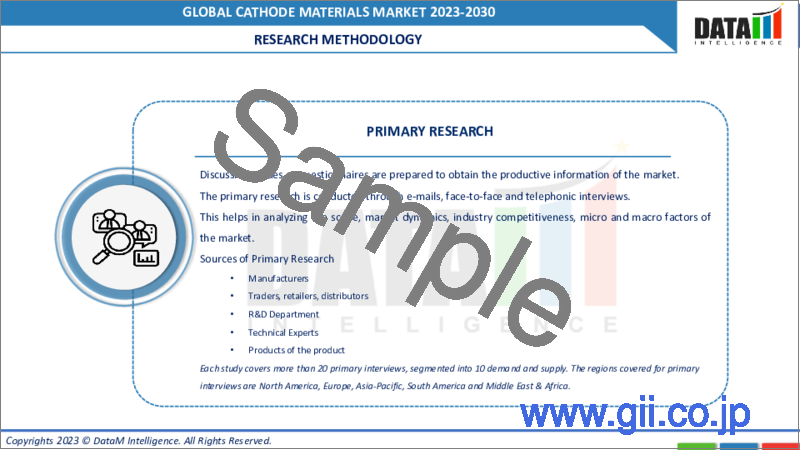|
|
市場調査レポート
商品コード
1336725
カソード材料の世界市場-2023年~2030年Global Cathode Materials Market - 2023-2030 |
||||||
|
● お客様のご希望に応じて、既存データの加工や未掲載情報(例:国別セグメント)の追加などの対応が可能です。 詳細はお問い合わせください。 |
|||||||
| カソード材料の世界市場-2023年~2030年 |
|
出版日: 2023年08月22日
発行: DataM Intelligence
ページ情報: 英文 195 Pages
納期: 約2営業日
|
- 全表示
- 概要
- 目次
市場概要
世界のカソード材料市場は2022年に243億米ドルに達し、2023-2030年の予測期間中にCAGR 14.7%で成長し、2030年には742億米ドルに達すると予測されています。
カソード材料市場の主な成長は、航空宇宙、防衛、自動車という様々な分野からの需要の増加によるものです。エネルギー貯蔵システムでは、カソードはグリッドレベルの貯蔵や住宅用エネルギー貯蔵に使用され、重要な役割を果たしています。このエネルギー貯蔵システムは再生可能エネルギーを貯蔵し、安定した電力供給の確保につながります。エネルギー貯蔵システムが成長するにつれて、カソード材料の需要もこれらの用途のために成長します。
アジア太平洋地域は、カソード材料市場において最も速い成長を示しており、世界シェア63.3%以上を占めています。中国、日本、インドのような国々は、カソード材料の生産と開発において著しい成長を見せています。主要企業は、地域の成長を加速させるため、この地域に投資しています。
例えば、2022年10月17日、Bechtelによって新しい製造施設が開発されました。この新しい施設ではリン酸鉄リチウムカソードが生産され、このカソードはそのエネルギー貯蔵能力から電気自動車に広く使用される予定です。ベクテル社はまた、ミトラケム社との提携も発表しており、両社は電池の技術革新に取り組んでいます。電池は電気自動車にとって重要な部品だからです。
市場力学
電気自動車の人気上昇
電気自動車の需要の増加は、カソード材料の成長に大きな影響を与えました。バッテリー電気自動車やハイブリッド車を含む電気自動車は、電池開発のためのカソード材料の使用量の増大に伴って増加しました。政府の支援とインセンティブは、カソード材料の成長を支える主要な原動力のひとつです。
政府はカソード材料採用のために様々な政策を実施し、電気自動車の成長にも影響を与えました。消費者はより持続可能な交通手段へとシフトしており、これがカソード材料の成長と発展の主な要因となっています。これらの要因により、リチウムイオン電池の需要は増加しています。
カソード材料が航空宇宙・防衛のエネルギー貯蔵に革命を起こす
カソード材料は、その信頼性と高エネルギー貯蔵ソリューションにより、航空宇宙・防衛分野で様々な用途があります。電池は、人工衛星で電力を生成するカソード材料を使用しています。技術の様々な成長により、人工衛星はソーラーパネルで生成されたエネルギーを貯蔵するバッテリーに依存しており、高出力が必要な場合はソーラーパネルからエネルギーが放出されます。カソード材料は航空宇宙・防衛分野で主に使用されており、企業はこの分野での材料需要を克服するために多額の投資を行っています。
例えば、2023年5月3日には、CATL電池が電気飛行機に電力を供給するというニュースが発表されました。最近上海で開催された自動車博覧会では、世界最大のバッテリーメーカーが、電気飛行機は1回の充電で1000キロメートルの飛行が可能だと主張しました。CATLは、産業が電動化に向かう中、この技術に取り組み始めました。
政府の厳しい規制
カソード材料の生産と開発には、高コストの原材料が必要です。政府の厳しい政策や規則は、カソード材料市場の成長低下につながります。環境と労働者を保護するために、カソード材料の生産に有害物質が使用されるため、政府は様々な規制を発表しました。
例えば、2023年2月8日、科学技術委員会の報告書では、マンガンベースの高エネルギーカソード材料の没落が取り上げられています。マンガンはスピネルカソード材料に使用される主要元素です。しかし、マンガン原料の価格はニッケルベースのカソードに比べて2倍です。
COVID-19影響分析
世界の政府による封鎖措置により、サプライチェーン管理システムに混乱が生じています。パンデミックはカソード材料のコスト上昇につながり、その中には高利のローンや株式投資家への利益還元も含まれます。COVIDはカソード材料市場に影響を与え、電池の価格が上昇します。経済的混乱はエネルギー貯蔵プロジェクトへの投資の減少につながります。
カソード材料の生産コストの上昇と融資の厳格化により、初期段階にあるプロジェクトは保留されます。多くの組織は、財政状況下でプロジェクトに投資することが難しく、それがプロジェクトの遅れにつながっています。リチウムイオン電池を使用する電気自動車の生産で最大の市場を持つ中国も影響を受け、中国に依存している企業は大きな損失を被っています。
ロシア・ウクライナ戦争の影響
ロシア・ウクライナ戦争により、カソード材料製造のための資源供給が影響を受けました。重要なニッケル、マンガン、リチウムのような資源は、地政学的緊張のために混乱に直面しています。これらの資源の不足は、価格の変動と遅れにつながります。紛争により、この地域の政府は貿易制限を課しました。
リチウムは、EVの生産に使用されるリチウムイオン電池の最も需要な部品のひとつです。投資家は地政学的な問題により、投資を控えています。紛争は、カソード材料市場の製造工場設立を含むプロジェクトへの投資を遅らせます。地政学的問題はカソード材料市場の成長と生産を減速させます。
目次
第1章 調査手法と調査範囲
第2章 定義と概要
第3章 エグゼクティブサマリー
第4章 市場力学
- 影響要因
- 促進要因
- 電気自動車の人気上昇
- 持続可能で高性能なエネルギー貯蔵ソリューションに対する需要の高まり
- 抑制要因
- 政府の厳しい規制
- コストと健康被害
- 機会
- 影響分析
- 促進要因
第5章 産業分析
- ポーターのファイブフォース分析
- サプライチェーン分析
- 価格分析
- 規制分析
第6章 COVID-19分析
第7章 材料別
- リン酸鉄リチウム(LFP)
- コバルト酸リチウム(LCO)
- ニッケルマンガンコバルトリチウム(NMC)
- リチウムニッケルコバルトアルミニウム(NCA)
- リチウムマンガン酸化物(LMO)
- 二酸化鉛
- その他
第8章 バッテリー別
- リチウムイオン電池
- 鉛酸電池
- その他
第9章 地域別
- 北米
- 米国
- カナダ
- メキシコ
- 欧州
- ドイツ
- 英国
- フランス
- イタリア
- ロシア
- その他欧州
- 南米
- ブラジル
- アルゼンチン
- その他南米
- アジア太平洋
- 中国
- インド
- 日本
- オーストラリア
- その他アジア太平洋
- 中東・アフリカ
第10章 競合情勢
- 競合シナリオ
- 市況/シェア分析
- M&A分析
第11章 企業プロファイル
- Umicore
- 会社概要
- 製品ポートフォリオと説明
- 財務概要
- 主な動向
- Sumitomo Metal Mining Co., Ltd.
- POSCO
- Zhejiang Huayou Cobalt
- Shenzhen Dynanonic Co., Ltd.
- Johnson Matthey
- Targray Technology International
- BASF SE
- Mitsubishi Chemical Corporation
- Kureha Corporation
第12章 付録
Market Overview
Global Cathode Materials Market reached US$ 24.3 billion in 2022 and is expected to reach US$ 74.2 billion by 2030 growing with a CAGR of 14.7% during the forecast period 2023-2030.
The major growth in the cathode material market is due to increasing demand from various sectors named aerospace, defense and automotive. In energy storage systems cathode plays a significant role as they are used in grid-level storage and residential energy storage. This energy storage system stores renewable energy which leads to ensuring a stable power supply. As energy storage system grows the demand for cathode materials also grows for these applications.
Asia-Pacific has shown the fastest growth in the cathode material market leading to contribute more than 63.3% share globally. Countries like China, Japan and India have shown tremendous growth in the production and development of cathode materials. Key players are investing in the region to accelerate regional growth.
For instance, on 17 October 2022, a new manufacturing facility develops by Bechtel. The new facility produces Lithium iron phosphate cathode and this cathode will be broadly used in electric vehicles due to its energy storage capacity. Bechtel also announces its partnership with Mitra Chem as they both are working on building innovation to the battery. As batteries are a critical component in electric vehicles.
Market Dynamics
Rising Popularity of Electric Vehicles
The increasing demand for electric vehicles significantly impacted the growth of cathode materials. Electric vehicles that include battery electric vehicles and hybrid electric vehicles increased due to an increase in the usage of cathode materials for the development of batteries. Government support and incentives are one of the primary drivers behind the growth of cathode materials.
The government implemented various policies for the adoption of cathode materials which also impacted the growth of electric vehicles. As consumers are shifting towards more sustainable transportation options that is the major factor for the growth and development of cathode materials. Due to these factors, the demand for lithium-ion batteries increases.
Cathode Materials Revolutionizing Energy Storage in Aerospace and Defense
The cathode materials have various applications in the aerospace and defense sector due to their reliable and high-energy storage solutions. Batteries use cathode materials that generate power in satellites. Due to various growth in technology satellites rely on batteries, which store energy generated by solar panels, when there is a need for high power the energy is released from these solar panels. Cathode materials have been predominantly used in the aerospace and defense sector and companies are heavily investing to overcome the material demand in the sector.
For instance, on 3 May 2023, news was released that CATL batteries will power electric airplanes. Recently auto expo was held in Shanghai in which the world largest battery maker claimed that electric aircraft has the capacity to fly 1000 kilometers on one single charge. CATL started working on this technology as industries are moving towards electrification.
Government Stringent Regulations
For production and development of cathode materials requires raw materials which are high in cost. Government stringent policies and rules lead to the downfall of the growth of the cathode material market. To protect the environment and worker government issued various restrictions as hazardous materials were used for the production of cathode materials.
For instance, on 8 February 2023, a report by the national research council of Science and Technology addresses the downfall in manganese-based high-energy cathode materials. Manganese is the main element used in spinel cathode materials. But the price of manganese raw material is double when compared to nickel-based cathodes.
COVID-19 Impact Analysis
Lockdown imposed by the government worldwide causes a disturbance in the supply chain management system. The pandemic led to increased costs of cathode materials that includes higher interest loans and returns for equity investors. COVID affects the cathode material market due to which the price of batteries increases. The economic disturbance leads to decrease investment in energy storage projects.
Due to the increase in the cost of production of cathode materials and stricter loans, the projects which are in their early stages are put on hold. Many organizations find it difficult to invest in projects under financial situations which leads to delays in projects. China which has the largest market for the production of electric vehicles that use lithium-ion batteries got affected, due to which companies which rely on China phase heavy losses.
Russia-Ukraine War Impact
Due to the Russia-Ukraine war, the supply of resources for manufacturing cathode materials was affected. Resources like critical nickel, manganese and lithium face disruptions due to geopolitical tensions. Shortage of these resources results in fluctuating prices and delays. Due to conflict government in this region imposed trade restrictions.
Lithium is one of the most demanding components of lithium-ion batteries which were used in the production of EVs. Investors step back with their investments due to geopolitical issues. The conflicts delay investment in projects that includes setting up manufacturing plants for the cathode materials market. Due to the war market phases geopolitical issues slow downs the growth and production of the cathode material market.
Segment Analysis
The global cathode materials are segmented based on material,battery and region.
Growing Demand for Lithium-Ion Cathode Materials in Electric Vehicles
Due to the rise in the growth of electric vehicles, the demand for cathode materials also increases. Electric vehicles majorly rely on lithium-ion batteries as they have better energy storage compared to traditional storage systems. EV requires fast charging infrastructure, so lithium-ion with cathode materials charges quickly and leads to reduce the time required to replenish batteries. The growing adoption of EVs in both developed and developing countries acts as a major driver for the lithium-ion cathode materials market leading it to cover more than 1/3rd globally.
Furthermore, lithium-ion batteries produce zero tailpipe emissions which lead to reduced greenhouse gas emissions and also improve the quality of air. As lithium-ion batteries have a lower impact on the environment when compared with other fossil fuels companies are contnorusly investing in adopting this material leading to improve market growth.
Geographical Penetration
Collaborative Ventures for the Production of Cathode Materials
Asia-Pacific, including China, Japan, India and South Korea witnessed major growth in the cathode materials market. China has had significant growth in the production of cathode materials which has made it contribute more than half share regionally. As the government has various rules and regulations due to which demand for cathode materials increases. Japan has various advanced technology in the automotive industry where cathode materials were used. Researchers in Japan and South Kore are working on the cathode material market and research is still going on.
For instance, on 18 April 2023, there is a collaboration between a South Korean chemical company and the Chinese company huayou cobalt for setting up a manufacturing plant for nickel, cobalt and manganese cathode materials in south korea. The factory setsup in the Saemangeum national industrial complex which has a production capacity of 50,000 tonnes of materials planned up to 2026. According to news South Korean company also plans for setting production plant for metal sulfates.
Competitive Landscape
The major global players in the market include: Umicore, Sumitomo Metal Mining Co., Ltd., POSCO, Zhejiang Huayou Cobalt, Shenzhen Dynanonic Co., Ltd. , Johnson Matthey, Targray Technology International, BASF SE, Mitsubishi Chemical Corporation, Kureha Corporation.
Why Purchase the Report?
- To visualize the global cathode materials market segmented based on material, battery and region, as well as understand key commercial assets and players.
- Identify commercial opportunities by analyzing trends and co-development.
- Excel data sheet with numerous data points of cathode Materials market-level with all segments.
- PDF report consists of a comprehensive analysis after exhaustive qualitative interviews and an in-depth study.
- Product mapping available as excel consisting of key product of all the major players.
The global cathode materials market report would provide approximately 53 tables, 50 figures and 195 Pages
Target Audience 2023
- Manufacturers/ Buyers
- Industry Investors/Investment Bankers
- Research Professionals
- Emerging Companies
Table of Contents
1. Methodology and Scope
- 1.1. Research Methodology
- 1.2. Research Objective and Scope of the Report
2. Definition and Overview
3. Executive Summary
- 3.1. Snippet By Material
- 3.2. Snippet By Battery
- 3.3. Snippet by Region
4. Dynamics
- 4.1. Impacting Factors
- 4.1.1. Drivers
- 4.1.1.1. Rising Popularity of Electric Vehicles
- 4.1.1.2. Rising Demand for Sustainable and High-Performance Energy Storage Solutions
- 4.1.2. Restraints
- 4.1.2.1. Government Stringent Regulations
- 4.1.2.2. Cost and Health Hazards
- 4.1.3. Opportunity
- 4.1.4. Impact Analysis
- 4.1.1. Drivers
5. Industry Analysis
- 5.1. Porter's Five Force Analysis
- 5.2. Supply Chain Analysis
- 5.3. Pricing Analysis
- 5.4. Regulatory Analysis
6. COVID-19 Analysis
- 6.1. Analysis of COVID-19
- 6.1.1. Scenario Before COVID
- 6.1.2. Scenario During COVID
- 6.1.3. Scenario Post COVID
- 6.2. Pricing Dynamics Amid COVID-19
- 6.3. Demand-Supply Spectrum
- 6.4. Government Initiatives Related to the Market During Pandemic
- 6.5. Manufacturers Strategic Initiatives
- 6.6. Conclusion
7. By Material
- 7.1. Introduction
- 7.1.1. Market Size Analysis and Y-o-Y Growth Analysis (%), By Material
- 7.1.2. Market Attractiveness Index, By Material
- 7.2. Lithium Iron Phosphate (LFP)*
- 7.2.1. Introduction
- 7.2.2. Market Size Analysis and Y-o-Y Growth Analysis (%)
- 7.3. Lithium Cobalt Oxide (LCO)
- 7.4. Lithium Nickel Manganese Cobalt (NMC)
- 7.5. Lithium Nickel Cobalt Aluminum (NCA)
- 7.6. Lithium Manganese Oxide (LMO)
- 7.7. Lead-Dioxide
- 7.8. Other
8. By Battery
- 8.1. Introduction
- 8.1.1. Market Size Analysis and Y-o-Y Growth Analysis (%), By Battery
- 8.1.2. Market Attractiveness Index, By Battery
- 8.2. Lithium-Ion *
- 8.2.1. Introduction
- 8.2.2. Market Size Analysis and Y-o-Y Growth Analysis (%)
- 8.3. Lead-Acid
- 8.4. Other
9. By Region
- 9.1. Introduction
- 9.1.1. Market Size Analysis and Y-o-Y Growth Analysis (%), By Region
- 9.1.2. Market Attractiveness Index, By Region
- 9.2. North America
- 9.2.1. Introduction
- 9.2.2. Key Region-Specific Dynamics
- 9.2.3. Market Size Analysis and Y-o-Y Growth Analysis (%), By Material
- 9.2.4. Market Size Analysis and Y-o-Y Growth Analysis (%), By Battery
- 9.2.5. Market Size Analysis and Y-o-Y Growth Analysis (%), By Country
- 9.2.5.1. U.S.
- 9.2.5.2. Canada
- 9.2.5.3. Mexico
- 9.3. Europe
- 9.3.1. Introduction
- 9.3.2. Key Region-Specific Dynamics
- 9.3.3. Market Size Analysis and Y-o-Y Growth Analysis (%), By Material
- 9.3.4. Market Size Analysis and Y-o-Y Growth Analysis (%), By Battery
- 9.3.5. Market Size Analysis and Y-o-Y Growth Analysis (%), By Country
- 9.3.5.1. Germany
- 9.3.5.2. UK
- 9.3.5.3. France
- 9.3.5.4. Italy
- 9.3.5.5. Russia
- 9.3.5.6. Rest of Europe
- 9.4. South America
- 9.4.1. Introduction
- 9.4.2. Key Region-Specific Dynamics
- 9.4.3. Market Size Analysis and Y-o-Y Growth Analysis (%), By Material
- 9.4.4. Market Size Analysis and Y-o-Y Growth Analysis (%), By Battery
- 9.4.5. Market Size Analysis and Y-o-Y Growth Analysis (%), By Country
- 9.4.5.1. Brazil
- 9.4.5.2. Argentina
- 9.4.5.3. Rest of South America
- 9.5. Asia-Pacific
- 9.5.1. Introduction
- 9.5.2. Key Region-Specific Dynamics
- 9.5.3. Market Size Analysis and Y-o-Y Growth Analysis (%), By Material
- 9.5.4. Market Size Analysis and Y-o-Y Growth Analysis (%), By Battery
- 9.5.5. Market Size Analysis and Y-o-Y Growth Analysis (%), By Country
- 9.5.5.1. China
- 9.5.5.2. India
- 9.5.5.3. Japan
- 9.5.5.4. Australia
- 9.5.5.5. Rest of Asia-Pacific
- 9.6. Middle East and Africa
- 9.6.1. Introduction
- 9.6.2. Key Region-Specific Dynamics
- 9.6.3. Market Size Analysis and Y-o-Y Growth Analysis (%), By Material
- 9.6.4. Market Size Analysis and Y-o-Y Growth Analysis (%), By Battery
10. Competitive Landscape
- 10.1. Competitive Scenario
- 10.2. Market Positioning/Share Analysis
- 10.3. Mergers and Acquisitions Analysis
11. Company Profiles
- 11.1. Umicore *
- 11.1.1. Company Overview
- 11.1.2. Product Portfolio and Description
- 11.1.3. Financial Overview
- 11.1.4. Key Developments
- 11.2. Sumitomo Metal Mining Co., Ltd.
- 11.3. POSCO
- 11.4. Zhejiang Huayou Cobalt
- 11.5. Shenzhen Dynanonic Co., Ltd.
- 11.6. Johnson Matthey
- 11.7. Targray Technology International
- 11.8. BASF SE
- 11.9. Mitsubishi Chemical Corporation
- 11.10. Kureha Corporation
LIST NOT EXHAUSTIVE
12. Appendix
- 12.1. About Us and Services
- 12.2. Contact Us




